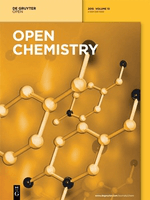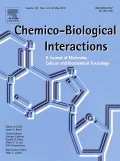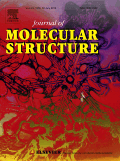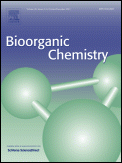
RUSSIAN JOURNAL OF BIOORGANIC CHEMISTRY
Scope & Guideline
Bridging Theory and Practice in Bioorganic Science
Introduction
Aims and Scopes
- Bioorganic Synthesis:
Research on the synthesis of organic compounds with biological activity, including methods such as microwave-assisted synthesis, one-pot reactions, and various chemical transformations. - Biological Evaluation:
Studies assessing the biological activity of synthesized compounds, including antimicrobial, anticancer, and antioxidant properties, often utilizing in vitro and in vivo models. - Molecular Docking and Computational Studies:
Use of computational techniques to predict the interactions of compounds with biological targets, aiding in the design of more effective drugs. - Chemical Biology:
Exploration of the chemical basis of biological processes, including studies on enzyme activity, protein interactions, and the role of small molecules in cellular functions. - Natural Products and Their Derivatives:
Investigations into the extraction, characterization, and modification of natural compounds, with a focus on their pharmacological potential. - Nanotechnology in Drug Delivery:
Research on the design and application of nanoparticle systems for targeted drug delivery and enhanced therapeutic efficacy.
Trending and Emerging
- CRISPR and Gene Editing Technologies:
There is a significant increase in research focusing on CRISPR/Cas9 systems and their applications in gene editing, reflecting the growing interest in precision medicine and genetic engineering. - Anticancer Drug Development:
A rising number of studies are dedicated to the design and synthesis of novel anticancer agents, particularly those targeting specific pathways or utilizing combination therapies. - Synthetic Antimicrobial Peptides:
Research on synthetic antimicrobial peptides is gaining momentum as an alternative to traditional antibiotics, focusing on their mechanisms of action and potential applications in treating resistant infections. - Nanoparticle-Based Drug Delivery Systems:
Emerging studies emphasize the use of nanoparticles for targeted drug delivery and enhanced therapeutic effects, indicating a shift towards more sophisticated drug formulation strategies. - Bioinformatics and Computational Drug Design:
An increasing trend in the use of computational methods for drug design and prediction of biological activity showcases the integration of bioinformatics in modern medicinal chemistry. - Natural Products with Anticancer Activity:
There is a renewed interest in natural products, particularly those with promising anticancer properties, leading to innovative derivatives aimed at improving efficacy and reducing side effects.
Declining or Waning
- Traditional Antibiotics:
Research on conventional antibiotic compounds has diminished as attention shifts towards novel antimicrobial strategies and drug resistance mechanisms. - Plant Extracts for Antimicrobial Activity:
While still relevant, the exploration of plant extracts has decreased in favor of synthetic compounds and targeted drug design, reflecting a broader trend towards more controlled and reproducible results. - Basic Pharmacognosy Studies:
The focus on basic pharmacognosy, such as the chemical composition of less-studied plant species, has waned as researchers prioritize more impactful and direct therapeutic applications. - Biomolecular Characterization:
Although important, the detailed characterization of biomolecules without a direct application or therapeutic implication has seen reduced interest compared to studies with clear pharmacological outcomes. - Simple In Vitro Assays:
The reliance on basic in vitro assays without advanced molecular docking or in vivo validation has decreased, with a growing preference for more complex and informative experimental designs.
Similar Journals

BIOORGANIC & MEDICINAL CHEMISTRY
Exploring the Nexus of Biology and MedicineBIOORGANIC & MEDICINAL CHEMISTRY, published by Pergamon-Elsevier Science Ltd, is a prominent journal in the fields of biochemical research and drug discovery, with an ISSN of 0968-0896 and an E-ISSN of 1464-3391. Established in 1993, it has garnered respect and recognition, evidenced by its categorization in various quartile ranks across 2023, including Q2 in Clinical Biochemistry and Pharmaceutical Science. It holds significant Scopus rankings, placing it in the 75th percentile in Pharmaceutical Science and 74th percentile in Organic Chemistry, highlighting its influential contributions to ongoing research and developments. This journal provides a platform for disseminating advancements in bioorganic and medicinal chemistry, focusing on innovative methodologies, therapeutic advancements, and molecular pharmacology. Although it does not follow an open-access model, it remains a key resource for researchers, professionals, and students aiming to stay at the forefront of scientific discovery in the UK and beyond. The journal’s commitment to enhancing knowledge within the biomedical community makes it an essential read for those passionate about this dynamic field.

CHEMISTRY OF NATURAL COMPOUNDS
Pioneering Research on Nature's Chemical WondersChemistry of Natural Compounds is a premier academic journal dedicated to the intersection of natural products and modern chemistry, published by Springer. Since its inception in 1965, this journal has published innovative research articles, reviews, and discussions that focus on the chemistry and biochemistry of natural compounds, with an emphasis on their applications in various fields including medicine, agriculture, and environmental science. Recognized for its contributions to the scientific community, the journal is indexed in key databases and holds a respectable impact factor that underscores its relevance in the academic landscape. Currently ranked in the Q3 category across multiple disciplines, including Biochemistry, Genetics and Molecular Biology, Chemistry, and Plant Science, it serves as a critical resource for researchers and professionals aiming to deepen their understanding of the complex interactions between natural compounds and biological systems. While not an open-access journal, Chemistry of Natural Compounds provides valuable insights and essential findings that can aid in advancing both theoretical and applied sciences for researchers, students, and industry practitioners alike.

Open Chemistry
Exploring New Horizons in Chemical ResearchOpen Chemistry, published by DE GRUYTER POLAND SP Z O O, is a distinguished peer-reviewed journal that has been serving the global chemistry community since its inception. With an ISSN of 2391-5420 and an E-ISSN also of 2391-5420, this open-access journal has been accessible to researchers and practitioners alike since 2015, ensuring a wide dissemination of high-quality research findings. Located in Germany, specifically at BOGUMILA ZUGA 32A STR, 01-811 WARSAW, MAZOVIA, POLAND, Open Chemistry aims to publish innovative research across various chemical disciplines, with special attention to miscellaneous chemistry and materials chemistry. It is currently ranked in the Q3 category for both fields as of 2023, reflecting its solid standing within the academic community, with specific ranks of 187/408 in General Chemistry and 153/317 in Materials Chemistry, corresponding to respective percentiles of 54 and 51. Open Chemistry not only enhances the accessibility of cutting-edge research but also serves as a vital resource for students, professionals, and scholars seeking to advance their knowledge in the rapidly evolving landscape of chemical sciences.

Heterocyclic Letters
Showcasing Breakthroughs in Heterocyclic CompoundsHeterocyclic Letters is an esteemed journal in the field of synthetic organic chemistry, published by RAMAN PUBL. With ISSN 2231-3087 and E-ISSN 2230-9632, this journal aims to disseminate original research and innovative findings related to heterocyclic compounds, which play a crucial role in medicinal chemistry, material science, and agricultural chemistry. Heterocyclic Letters provides a platform for researchers, professionals, and students to share their insights and advancements, thus fostering academic collaboration and knowledge transfer. The journal is dedicated to maintaining high-quality standards in research publication, making it an essential resource for anyone focused on the latest developments in heterocyclic chemistry. Although it does not currently offer Open Access options, the journal’s rigorous peer-review process ensures that only the most credible and impactful studies are published, contributing significantly to the advancement of the field.

ARKIVOC
Fostering Global Collaboration in Organic Chemistry ResearchARKIVOC is an esteemed open-access journal dedicated to the field of Organic Chemistry, published by ARKAT USA INC. Since its inception in 2000, ARKIVOC has aimed to disseminate high-quality research and advancements in organic chemistry, fostering an international exchange of knowledge within this ever-evolving discipline. With its ISSN 1551-7004 and E-ISSN 1551-7012, the journal is committed to providing accessible content free of charge to researchers, students, and professionals around the globe. Although currently categorized in the fourth quartile of Organic Chemistry with a Scopus rank of #188 out of 211, ARKIVOC continues to encourage the publication of innovative works and critical reviews that highlight emerging trends and methodologies in organic synthesis, reaction mechanisms, and material sciences. Its open-access model since 2000 ensures that valuable contributions to scientific knowledge are widely available, promoting collaboration and discovery. The journal is based in the United States, with its editorial office located at the University of Florida, under the guidance of prominent chemists. ARKIVOC provides an essential platform for those deeply engaged in organic chemistry research, supporting the advancement of science for future generations.

CHEMICO-BIOLOGICAL INTERACTIONS
Bridging Disciplines to Enhance Public SafetyCHEMICO-BIOLOGICAL INTERACTIONS is a premier journal published by Elsevier Ireland Ltd, dedicated to advancing the field of chemical and biological interactions since its inception in 1969. With a robust focus on pharmacology and toxicology, the journal holds a prestigious Q1 ranking in both Medicine (miscellaneous) and Toxicology, reflecting its significance in disseminating influential research. As part of the Scopus database, it ranks #21 out of 133 journals in Toxicology, positioning it in the 84th percentile and ensuring high visibility for cutting-edge studies. This scholarly platform serves as a crucial resource for researchers, professionals, and students who seek reliable and innovative findings at the intersection of chemistry and biology. While currently not open access, CHEMICO-BIOLOGICAL INTERACTIONS provides a comprehensive collection of articles that contribute to the ongoing dialogue in toxin research and its implications on medicinal chemistry, thereby fostering advancements in public health and safety.

INDIAN JOURNAL OF HETEROCYCLIC CHEMISTRY
Empowering Scientific Dialogue in Heterocyclic ChemistryINDIAN JOURNAL OF HETEROCYCLIC CHEMISTRY, published by CONNECT JOURNALS, is a vital resource in the fields of organic chemistry and biochemistry, aiming to advance research and promote innovation within the realm of heterocyclic compounds. Established in 1996, this journal has successfully converged into an influential publication with a commitment to disseminating high-quality, peer-reviewed research articles that enhance the understanding of heterocyclic chemistry applications. Although it currently holds a Q4 quartile ranking in both biochemistry and organic chemistry according to the 2023 categorizations, its broader contributions to the scientific community should not be underestimated, as it seeks to support the ongoing dialogue among researchers, professionals, and students. The journal operates from Ghaziabad, India, providing open access to its publications, thereby fostering a collaborative and informative environment for its international readership. With an ISSN of 0971-1627 and a special focus on contemporary challenges and developments in the field, the INDIAN JOURNAL OF HETEROCYCLIC CHEMISTRY is poised to make a significant impact as it continues to evolve through 2024 and beyond.

Journal of Molecular Structure
Empowering researchers with cutting-edge molecular research.Journal of Molecular Structure is a premier publication in the field of chemistry, offering a platform for innovative research that spans analytical, inorganic, organic chemistry, and spectroscopy. Published by Elsevier in the Netherlands, this journal is committed to advancing the understanding of molecular architecture and behavior through high-quality, peer-reviewed articles. With its impressive impact factor and a notable Scopus ranking placing it in the top quartiles among its peers, it serves as an essential resource for researchers, professionals, and students alike. The journal's open access options promote the dissemination of knowledge, ensuring that groundbreaking discoveries reach a broad audience. Established in 1967 and projected to continue through 2025, the Journal of Molecular Structure is vital for anyone engaged in the study of molecular interactions and structural analysis.

BIOINORGANIC CHEMISTRY AND APPLICATIONS
Fostering scientific dialogue in bioinorganic applications.BIOINORGANIC CHEMISTRY AND APPLICATIONS, published by HINDAWI LTD, is a distinguished journal dedicated to advancing the field of bioinorganic chemistry, offering an open access platform since 2008. With an ISSN of 1565-3633 and E-ISSN of 1687-479X, this journal provides a global forum for researchers, practitioners, and scholars in the vibrant fields of Biochemistry, Inorganic Chemistry, and Organic Chemistry. Recognized for its scholarly impact, it holds an impressive Q2 rank in Biochemistry and Q1 ranks in both Inorganic and Organic Chemistry in the 2023 metrics. Catering to a diverse audience, the journal emphasizes the importance of interdisciplinary research and the application of inorganic chemistry in biological systems. With an accessible range of articles aimed at fostering scientific dialogue and innovation, BIOINORGANIC CHEMISTRY AND APPLICATIONS plays a crucial role in shaping future research and application in the chemical sciences.

BIOORGANIC CHEMISTRY
Unveiling the synergy between chemistry and biology.BIOORGANIC CHEMISTRY, published by Academic Press Inc., a prestigious imprint of Elsevier Science, represents a cornerstone in the fields of biochemistry, organic chemistry, and drug discovery. With an impressive Scopus rank placing it in the top quartiles across critical categories—including Q2 for Biochemistry and Drug Discovery, and Q1 for Organic Chemistry—this journal has established itself as a vital resource for researchers, professionals, and students alike. Featuring a diverse array of articles that explore innovative methodologies and emerging trends from 1971 to the present, BIOORGANIC CHEMISTRY effectively bridges the gap between laboratory research and practical applications. Although not an Open Access journal, its rigorous peer-review process ensures the delivery of high-quality, impactful research that drives advances in the understanding and application of biochemistry. With an aim to facilitate scientific discourse and collaboration, it invites contributions that further the exploration of chemical processes within biological systems.